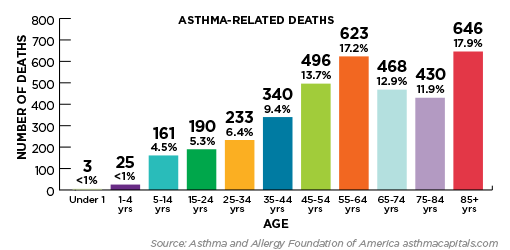
Asthma is one of the most prevalent diseases in the U.S. If you are one of the 25 million with asthma, you can manage it with a proper treatment plan and by avoiding triggers. But where you live can actually make managing your asthma more challenging.
The Asthma and Allergy Foundation of America (AAFA) has released the 2018 Asthma Capitals® report. This report ranks the top 100 cities in the U.S. where it’s challenging to live with asthma. AAFA’s report shows how community factors can drive up asthma rates. Springfield, Massachusetts, is AAFA’s #1 Asthma Capital for 2018.
We ranked each city based on these asthma outcomes:
- Asthma prevalence (or occurrence)
- Asthma-related emergency room visits
- Asthma-related deaths

Here are the top 20 Asthma Capitals:
- Springfield, Massachusetts
- Richmond, Virginia
- Dayton, Ohio
- Philadelphia, Pennsylvania
- Louisville, Kentucky
- Cincinnati, Ohio
- Youngstown, Ohio
- Birmingham, Alabama
- Greensboro, North Carolina
- Toledo, Ohio
- Boston, Massachusetts
- Worcester, Massachusetts*
- Omaha, Nebraska*
- Milwaukee, Wisconsin
- Cleveland, Ohio
- Detroit, Michigan
- Winston-Salem, North Carolina
- Akron, Ohio
- Hartford, Connecticut
- New York, New York
*Tie
Creating an Asthma-Friendly Home
Controlling triggers is a key part of asthma management. And while where you live can affect your asthma, you can use Certified Asthma & Allergy Friendly® products to improve the air quality in your home to reduce exposure to triggers.
- According to AAFA, here are some ways to create an asthma-friendly home:
- Use a Certified filter in your air conditioning system
- Protect yourself from dust mites in your bedroom by using allergen barrier mattress and pillow covers
- Vacuum floors weekly with a certified vacuum cleaner
- Don’t allow smoking in your home or car
- Avoid heavily scented products like candles, potpourri and wax melts
- Use “green” or unscented cleaning products
- Keep your windows closed during high pollen season or on poor air quality days
These are just some of the ways you can improve your home’s air quality. Whether you live in an Asthma Capital or not, creating a healthier home can be a big step toward managing your asthma.
Reducing Rates
“Warmer temperatures from climate change are increasing ground-level ozone levels, especially in more urban, industrialized areas,” says Kenneth Mendez, President and CEO of AAFA. “This, combined with a lack of policies to protect those with asthma living in poorly maintained rental housing and inadequate health care, creates a perfect storm of asthma prevalence. We’ve seen ways communities can make changes to help asthma patients. This report shows us where we can focus to provide solutions to improve the health and quality of life in urban areas for asthma patients.”
Each day, 10 people die from asthma. That’s 10 too many. AAFA has released this report to start the conversation about how local, state and federal leaders can improve their communities to make life better for those with asthma.

Learn More About the Report
The Asthma Capitals® ranking is an annual research and educational project of AAFA, designed to help patients recognize, prevent and manage asthma symptoms. Through this ranking, AAFA raises awareness about the impact of asthma and highlights how communities can make improvements to better serve their residents and visitors with asthma. The ranking is based on asthma prevalence, emergency room visits and mortality rates. The report also looks at risk factors, including poverty, air quality and access to specialists. Visit AsthmaCapitals.com to see the full list of 100 cities, methodology and to learn more about asthma management.
To see the full list of Top 100 Asthma Capitals, download our report.
The 2018 Asthma Capitals report is an independent research project of AAFA made possible by Sanofi Genzyme and Regeneron.
